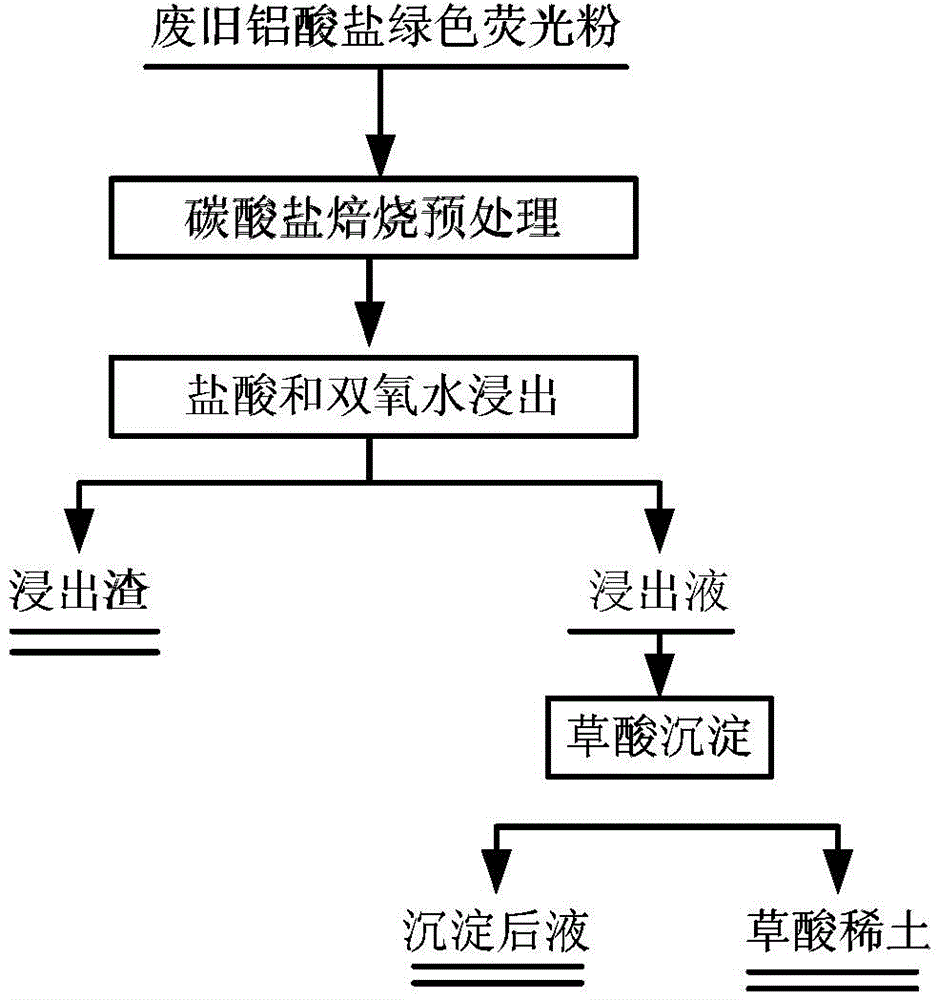A method for recovering rare earth from waste aluminate green rare earth phosphor
A technology of rare earth phosphor and aluminate, which is applied in the direction of metal recovery, recycling technology, process efficiency improvement, etc., can solve the problems of high cost, low rare earth recovery rate, and complicated steps and processes, and achieve low cost and rare earth recovery. The effect of high efficiency and simple steps
- Summary
- Abstract
- Description
- Claims
- Application Information
AI Technical Summary
Problems solved by technology
Method used
Image
Examples
Embodiment 1
[0013] Take 20g of waste green rare earth phosphor and 26g of sodium carbonate and mix evenly, put the mixture into an electric furnace whose temperature is raised to 800°C, react for 3 hours, take it out and cool it to 65°C, then grind the roasted product, after grinding The particle size of the calcined product is -100 mesh, and then enter the following steps.
[0014] Take the roasted product and mix it with hydrochloric acid and hydrogen peroxide. The leaching conditions are: leaching temperature 95°C, leaching time 3h, liquid-solid ratio 11:1, hydrochloric acid concentration 1mol L -1 , the hydrogen peroxide is 5% of the leachate volume, and the stirring speed is 300r / min. After the reaction, solid-liquid separation was carried out, and the leachate was analyzed for rare earth content, and the rare earth leaching rate was calculated to be 93.4%.
[0015] Use the oxalic acid solution with a concentration of 600g / L as the precipitant to precipitate the rare earth in the ra...
Embodiment 2
[0017] Take 20g of waste green rare earth phosphor and 20g of potassium carbonate and mix evenly, put the mixture into an electric furnace whose temperature is raised to 800°C, react for 3 hours, take it out and cool it to 75°C, and then grind the roasted product, after grinding The particle size of the calcined product is -100 mesh, and then enter the following steps.
[0018] Take the roasted product and mix it with hydrochloric acid and hydrogen peroxide. The leaching conditions are: leaching temperature 65°C, leaching time 0.5h, liquid-solid ratio 18:1, hydrochloric acid concentration 4mol L -1 , the hydrogen peroxide is 2% of the leachate volume, and the stirring speed is 600r / min. After the reaction, solid-liquid separation was carried out, and the leachate was analyzed for rare earth content, and the rare earth leaching rate was calculated to be 94.1%.
[0019] Use the oxalic acid solution with a concentration of 700g / L as the precipitant to precipitate the rare earth ...
Embodiment 3
[0021] Take 20g of waste green rare earth phosphor and 12g of sodium carbonate and mix evenly, put the mixture into an electric furnace whose temperature is raised to 1000°C, react for 1h, take it out and cool it to 70°C, then grind the roasted product, after grinding The particle size of the calcined product is -100 mesh, and then enter the following steps.
[0022] Take the roasted product and mix it with hydrochloric acid and hydrogen peroxide. The leaching conditions are: leaching temperature 75°C, leaching time 1h, liquid-solid ratio 15:1, hydrochloric acid concentration 2mol L -1 , the hydrogen peroxide is 4% of the leachate volume, and the stirring speed is 400r / min. After the reaction, solid-liquid separation was carried out, and the leachate was analyzed for rare earth content, and the rare earth leaching rate was calculated to be 93.9%.
[0023] Use the oxalic acid solution with a concentration of 800g / L as the precipitant to precipitate the rare earth in the rare e...
PUM
| Property | Measurement | Unit |
|---|---|---|
| concentration | aaaaa | aaaaa |
Abstract
Description
Claims
Application Information
 Login to View More
Login to View More - R&D
- Intellectual Property
- Life Sciences
- Materials
- Tech Scout
- Unparalleled Data Quality
- Higher Quality Content
- 60% Fewer Hallucinations
Browse by: Latest US Patents, China's latest patents, Technical Efficacy Thesaurus, Application Domain, Technology Topic, Popular Technical Reports.
© 2025 PatSnap. All rights reserved.Legal|Privacy policy|Modern Slavery Act Transparency Statement|Sitemap|About US| Contact US: help@patsnap.com

